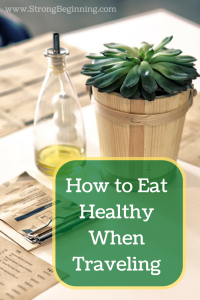We’ve talked about making healthy food choices at home and at a party, but what about when you are out of town? Can you still eat healthy when traveling?
The answer is yes. Here are 10 tips to help you make wise choices when you are away from home.
1. Pack non-perishable healthy snacks before you go. This could include nuts and seeds, jerky, or protein bars.
2. Drink lots of water. Take your own water bottle and fill it at the hotel’s fitness center. This should be free, filtered water which is better than the room’s tap water and cheaper than paying for plastic bottles of water.
3. Choose a hotel room with a kitchenette if possible. If not, but the room has a mini-bar, ask in advance for the fridge to be emptied. That way you can use it as a fridge during your stay. Visit a local grocery store after arriving and stock it with fruit, yogurt, low-sodium lunch meat, and veggies.
4. Make wise choices. If the hotel offers a continental breakfast, stick to fruit, yogurt, and no-sugar-added oatmeal. Scrambled or hard-boiled eggs are another good option. Be mentally prepared to resist the sweet rolls, sugary cereals, and fatty meats like bacon and sausage.
When eating at restaurants:
5. Do your research ahead of time. Visit HealthyDiningFinder.com. This website allows you to input your city/state and any dining preferences you might have (low cal, low sodium, low carb, etc.), and it returns local restaurants and how many healthy meal options they offer that meet your criteria. By clicking on the restaurant, you receive details about each meal option along with nutritional information. It also provides the restaurant’s address, directions, phone number, and hours of operation. HealthyOut is a free mobile app (for Apple and Android devices) that does roughly the same thing.
6. Have it your way. When ordering your meal at a restaurant, be assertive and make special requests. Ask to have an item grilled instead of fried. Ask for steamed vegetables instead of french fries. Ask for a green salad instead of coleslaw or pasta salad. You may have to pay for a substitution, but many restaurants will accommodate your request(s) for free. You can even ask for “double” veggies.
7. Beware: Not all salads are created equal. Most people assume salad is a healthy option, but many salads include cheese, bacon, calorie-laden dressings, crispy noodles, tortilla strips, or fried croutons. Read all the ingredients carefully and ask for items to be removed or served on the side if necessary. In fact, salad dressing is best to be served on the side. Dip your empty fork in the dressing before spearing a mouthful of greens, and you’ll be surprised by how little dressing you use and how balanced the flavor is.
8. Watch your portion sizes. Many restaurant meals are over-sized. You do not need to eat all of the food served to you. When you receive your order, determine the appropriate portions, and move the excess food to the side of your plate or an extra plate. If you have a way to preserve the extra food, ask for a to-go container when you order your meal. If possible, order a reduced portion entree or a healthy appetizer with a side salad.
9. Plan for a special meal. When traveling to new areas, many people like to try the special food(s) of that region, but these will not always be low-fat options. Plan one or two special meals during your trip, and then try to eat as smart and healthy as possible at your other meals.
When you return home:
10. Remember the fun you had on your trip, but get right back to your regular eating plan. Even if you slipped or splurged when you were away, forgive yourself and move forward. Do not give up! Re-establish the healthy habits you worked so hard to develop before you left.
Here’s to a fabulous and healthy trip. Safe travels!
What do you consider when making food choices away from home?







These are great ideas! When I travel, I pack breakfast foods with me. This saves money AND calories.
Good strategy, Denise. Starting your day off right also sets the stage for a healthy day. Thank you for sharing!